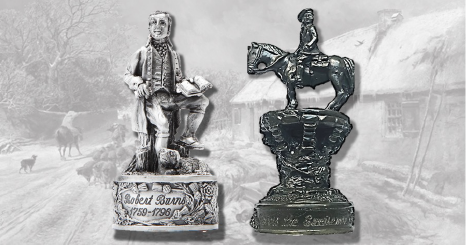Just five of the things that make the Robert Burns chess set special
A unique responsibility
Very few chess sets in the world have as much thought, care and attention paid to their creation as the Robert Burns and Battle of Bannockburn Chess Sets, with a remarkable bonus for chess players:
Have you ever played with a chess set where all 32 pieces are different? Only then do you have the additional responsibility for each character on the board – losing a pawn is one thing but losing Tam O’Shanter, the Twa Dogs, or Holy Willie is suddenly a bit more personal – and could you take the responsibility of losing Bonnie Prince Charlie, or a Jolly Beggar; Kirk Alloway or even Burns Cottage?
Whenever we play at home and it looks like we’re about to lose Highland Mary or Burns the Exciseman, we switch the pieces around. Which probably breaks every rule in the book – but then, games of chess aren’t won by Queensberry Rules!
Robert Burns - playing both sides
Robert Burns has the unusual honour of appearing in both the light and the dark side of the Robert Burns Chess set, although “honour” might be stretching it a bit. In the greatest irony of the Robert Burns Chess Set, the poet not only appears as the white king in his own right but as a knight on the dark side – as the Exciseman.
Burns spent his last seven years riding through Scotland as a diligent tax collector, travelling many hundreds of miles each week on horseback, in pursuit of his duties. This gave him not a few “moral” problems as he crossed the paths in conflict with those he might otherwise support.
It is suggested that, at the time of his death, he was being considered for promotion. Irony indeed, as he had previously reviled the calling in “The De’ils Awa Wi’ the Exciseman.”
“The de’il cam fiddlin thro’ the town,
And danc’d awa wi the Exciseman,
And ilka wife cries ‘Auld Mahun’
I wish you luck o’ the prize, man.”
The words on the board
There are other beautiful chess sets in the world but few can claim to have a chessboard offering such style and intrigue. All 32 of the light board squares are etched with different quotations from the work of Burns – in his own hand – half the squares pointing towards one player, the other half towards his or her opponent.
Some are single quotes while others, like “Scots Wha Hae”, “Tam O’Shanter” and “To a Mouse”, meander across the board in sequence.
In reproducing the verse, we were determined to be as authentic as possible and scanned the many existing samples of Burns’ handwriting but there was not enough consistency to create a ‘writing’ close to his.
Then, almost by accident, we discovered that a Robert Burns handwriting font actually existed, designed by artist Shirley Lochhead in 2010, commissioned by the National Trust for Scotland for their Robert Burns Birthplace Museum in Alloway.
And so, was created a playing board that is as much a work of art as a joy to own.
Of witches and cutty sarks
Seldom have two halves of a story been so easy to illustrate in a chess set than that of the hapless yet ultimately lucky Tam O’ Shanter and the apprentice witch, “Nannie Dee”.
As one of the light side knights in the Robert Burns Chess Set, we see the terrified Tam clearing the threshold of the bridge over the “running stream they (the pursuing witches) dare na cross”.
His trusty steed Maggie is minus her tail which is already in the hands of the dark side queen.
In this buxom representation of the young witch, we see the famous “Cutty Sark” (short underskirt) which Nannie wore so brazenly and from which was taken the name of the world’s most famous Tea Clipper.
“Her cutty-sark, o’ Paisley harn, That while a lassie she had worn,
in longitude tho’ sorely scanty. It was her best and she was vauntie”
The man who would be Burns
Quite simply, there could be no better accolade for our Robert Burns Chess set than to receive the unqualified endorsement of Scottish writer, actor, painter and raconteur, John Cairney.
Internationally known through his many one-man shows, John Cairney’s association with Burns began in 1965 when he played the role of Robert Burns in Tom Wright’s solo play ‘There Was a Man’. His acting career included the title role in the BBC television series, ‘This Man Craig’ and a brush with Hollywood, in films such as A Night to Remember, Cleopatra and Jason and the Argonauts.
But it was his association with Robert Burns that was to become the driver of his life, taking over the direction of his career.
In 1968, he wrote and starred in a six-week television adaptation of the Robert Burns Story for Scottish Television. The rest, as they say, is history.
Only in his latter years, was John Cairney been able to lay down the cloak of Burns and return to writing and painting at his own leisure. And so, it was all the more delightful for us that he chose to become involved with our Robert Burns Chess set.
Marking that partnership and the true friendship that evolved between us over the years, we are delighted and honoured to include with each Robert Burns Chess Set, an exclusive booklet reproducing the first-ever, John Cairney Immortal Memory and the set’s numbered, Limited Edition certificate, signed by the man himself.





